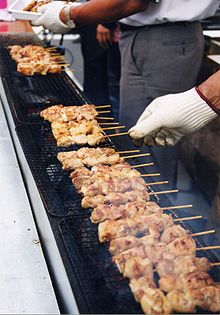This article has multiple issues. Please help improve it or discuss these issues on the talk page. (Learn how and when to remove these template messages)
|


Yakitori (焼き鳥, やきとり, ヤキトリ), grilled chicken, is a Japanese type of skewered chicken.
The preparation of Yakitori involves skewering the meat with kushi (串, くし), a type of skewer typically made of steel, bamboo, or similar materials. Afterwards, they are grilled over a charcoal fire. During or after cooking, the meat is typically seasoned with tare sauce or salt.
Preparation edit
As they are designed for convenience and portability, yakitori are typically cooked using methods which are easy to transport or stow away.
Traditionally, this was accomplished by using portable charcoal grills. This is the method most often employed by yatai, however, restaurants may use stationary grills, and depending on the situation, higher quality binchōtan charcoal.
For home use, various appliances known as Yakitori-ki (焼き鳥器, やきとりき) (lit. "Yakitori device") are used. Yakitori-ki are small electrical appliances which use a heating element similar to that of a broiler or toaster to cook the food placed on top.
In order to facilitate even cooking, the meat is cut into small, roughly uniform shapes and then skewered with kushi; after which the yakitori are seasoned and cooked. Charcoal is the preferred method of cooking as it produces high heat and strong flames while giving off little to no water vapor. This allows for the ingredients to cook quickly while imparting a crunchy texture to the skin. While gas and electric heat sources can be used, they do not develop the same aromas or textures as charcoal-cooked yakitori.
Seasoning edit
Yakitori seasonings are primarily divided among two types: salty or salty-sweet. Likewise, the seasonings also reflect this division. The salty type usually uses plain salt as its main seasoning. For the salty-sweet variety, tare, a special sauce consisting of mirin, sake, soy sauce, and sugar is used. Other common spices include powdered cayenne pepper, shichimi, Japanese pepper, black pepper, and wasabi, according to one's tastes.
Sales edit
Yakitori-ya' (焼き鳥屋, やきとりや) are small shops specializing in yakitori. They usually take the form of a compact shop offering take-out services only, but sit-down restaurants and restaurant chains are also popular.
Yakitori isn't limited to speciality shops, however. It is readily found on the menus of izakaya all across Japan, and also sold pre-cooked, as frozen vacuum packs, or even canned, the latter of which being a popular mainstay of vending machines.
Due to its ease of preparation and portability, yakitori is a very popular street food, often sold from small carts and stalls known as yatai. Yatai are found, among other places, dotting streets during festivals or on heavily trafficked routes during the evening commute.
Kushiyaki edit
Kushiyaki (串焼き, くしやき), is a formal term that encompasses both poultry and non-poultry items, skewered and grilled. Both yakitori and kushiyaki are used interchangeably in Japanese society to refer to skewered meat collectively; however, when referring to a specific item, yakitori will not be used unless the primary meat is chicken.
Examples edit
Yakitori edit
Yakitori uses many different cuts of chicken along with many different ways to prepare it, resulting in a great amount of variation in types. Some popular examples include:
- momo (もも), chicken thigh
- "negima" (ねぎま), chicken and spring onion
- tsukune (つくね), chicken meatballs
- (tori)kawa ((とり)かわ), chicken skin, grilled until crispy
- tebasaki (手羽先), chicken wing
- bonjiri (ぼんじり), chicken tail
- shiro (シロ), chicken small intestines
- nankotsu (なんこつ), chicken cartilage
- hāto / hatsu (ハート / ハツ) or kokoro (こころ), chicken heart
- rebā (レバー), liver
- sunagimo (砂肝) or zuri (ずり), chicken gizzard
- toriniku (鶏肉), all white meat on skewer
- yotsumi (四つ身), pieces of chicken breast
Kushiyaki edit
The following examples are not yakitori in the strictest sense of the word, and are better classified as "kushiyaki", as they do not use poultry.
- ikada (筏) (lit. raft), Japanese scallion, with two skewers to prevent rotation
- gyūtan (牛タン), beef tongue, sliced thinly
- atsuage tōfu (厚揚げとうふ), thicker variety of deep-fried tofu
- enoki maki (エノキ巻き), enoki mushrooms wrapped in slices of pork
- pīman (ピーマン), green bellpepper
- asuparabēkon (アスパラベーコン), asparagus wrapped in bacon
- butabara (豚ばら), pork belly
- ninniku (にんにく), garlic
- shishito (獅子唐), Japanese pepper
Gallery edit
See also edit
- Brochette
- Japanese cuisine
- List of chicken dishes
- Satay
- Souvlaki similar looking skewered food
References edit
- Ono, Tadashi; Salat Harris (2011). The Japanese Grill: From Classic Yakitori to Steak, Seafood, and Vegetables. Ten Speed Press. ISBN 9781580087377
External links edit
"Udon Noodles." Udon Noodles. Web. 18 Apr. 2015. <http://www.japan-guide.com/r/e105.html>.
Category:Meat dishes Category:Chicken dishes Category:Skewered foods Category:Street food Category:Barbecue Category:Japanese cuisine Category:Japanese cuisine terms